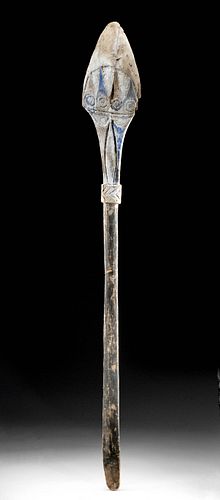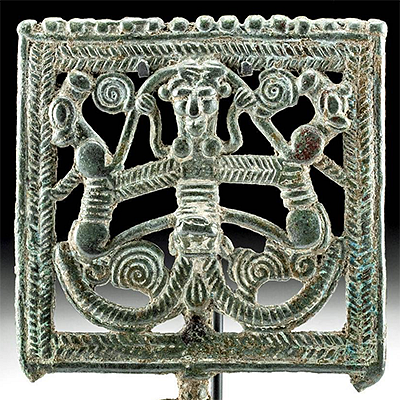20th C. Papua New Guinea New Britain Tolai Dance Axe
Lot 101a
About Seller
Artemis Gallery
686 S Taylor Ave, Ste 106
Louisville, CO 80027
United States
Selling antiquities, ancient and ethnographic art online since 1993, Artemis Gallery specializes in Classical Antiquities (Egyptian, Greek, Roman, Near Eastern), Asian, Pre-Columbian, African / Tribal / Oceanographic art. Our extensive inventory includes pottery, stone, metal, wood, glass and textil...Read more
Categories
Estimate:
$900 - $1,400
Absentee vs Live bid
Two ways to bid:
- Leave a max absentee bid and the platform will bid on your behalf up to your maximum bid during the live auction.
- Bid live during the auction and your bids will be submitted real-time to the auctioneer.
Bid Increments
| Price | Bid Increment |
|---|---|
| $0 | $25 |
| $300 | $50 |
| $1,000 | $100 |
| $2,000 | $250 |
| $5,000 | $500 |
| $10,000 | $1,000 |
| $20,000 | $2,500 |
| $50,000 | $5,000 |
| $100,000 | $10,000 |
| $200,000 | $20,000 |
About Auction
By Artemis Gallery
Nov 5, 2020
Set Reminder
2020-11-05 10:00:00
2020-11-05 10:00:00
America/New_York
Bidsquare
Bidsquare : Ancient & Ethnographic From Around the World
https://www.bidsquare.com/auctions/artemis-gallery/ancient-ethnographic-from-around-the-world-5916
Ancient art from Egypt, Greece, Italy and the Near East, as well as Asian, Pre-Columbian, Native American, African / Tribal / Oceanic, Spanish Colonial, Russian Icons, Fine art, much more! All categories, all price ranges... all legally acquired and guaranteed to be as described or your money back. Artemis Gallery info@artemisgallery.com
Ancient art from Egypt, Greece, Italy and the Near East, as well as Asian, Pre-Columbian, Native American, African / Tribal / Oceanic, Spanish Colonial, Russian Icons, Fine art, much more! All categories, all price ranges... all legally acquired and guaranteed to be as described or your money back. Artemis Gallery info@artemisgallery.com
- Lot Description
Oceania, Papua New Guinea, East New Britain province, Tolai culture, ca. early to mid 20th century. A rare Tolai New Britain ceremonial dance axe (pem) with a finely decorated terminal. The ovoid terminal is incised with a wonderful composition comprised of concentric circles, nested triangles, and hemispheric motifs with a narrowing section below that resolves in a cylindrical collar/base incised with repeated chevrons. There are also nice remains of pigment adorning the surface. Size: 6.5" W x 46.75" H (16.5 cm x 118.7 cm)
See a ceremonial dance axe (pem) in the Bowers Museum collection - accession number 2014.18.1. According to the Bowers Museum description for this piece, "The pem of the Tolai people are a part of a group of sacred objects known as pokopoko. Wooden pokopoko were typically made out of rosewood (ruga) or other hardwood bearing trees. The pem was used ritually in a ceremony associated with the death of a high-ranking deceased member of the community. This ceremony is referred to as tubuan i takin, which translates to, 'tubuan in search of deceased spirit.' A tubuan mask represents an older woman within the tubuan secret society and it is worn by a man. To prepare for the events of the ceremony, the pem is painted with red paint and the tubuan performs dances from night until dawn. In a moment of complete silence except for the playing of sacred music, the tubuan prepares to pick up the pem. The ceremony then transitions to the deceased person’s home. Out of the darkness, the tubuan appears with the pem. An elder of the tubuan society calls the tubuan by name. At this point, the tubuan runs violently, stepping on the doorstep of the deceased’s home. A fellow unmasked tubuan society member runs after the masked tubuan, chopping whatever she might put her foot on. After this is completed, the pem is returned to a special and sacred place. More singing and dancing continues until daybreak and through to the following day when the exchange and the distribution of shell money and food also takes place among community members." (Bowers Museum Collection online blog)
Provenance: private Tucson, Arizona, USA collection, acquired between 1950 and 1985
All items legal to buy/sell under U.S. Statute covering cultural patrimony Code 2600, CHAPTER 14, and are guaranteed to be as described or your money back.
A Certificate of Authenticity will accompany all winning bids.
We ship worldwide and handle all shipping in-house for your convenience.
#156088The ovoid terminal of the pem has been repaired from two large pieces. May be missing an axe blade from the opposite end. Small losses from peripheries with the wood weathered and split in some places. Nice preservation of motifs and pigment.Condition
- Shipping Info
-
All shipping is handled in-house for your convenience. Your invoice from Artemis Gallery will include shipping calculation instructions. If in doubt, please inquire BEFORE bidding for estimated shipping costs for individual items.
-
- Buyer's Premium



 EUR
EUR CAD
CAD AUD
AUD GBP
GBP MXN
MXN HKD
HKD CNY
CNY MYR
MYR SEK
SEK SGD
SGD CHF
CHF THB
THB














